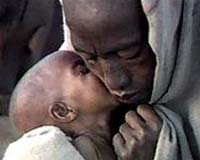| . |  |
. |
Montevideo (AFP) Nov 18, 2009 From a devastating food crisis in Guatemala to water cuts in Venezuela, El Nino has compounded drought damage across Latin America this year. The occasional seasonal warming of central and eastern Pacific waters upsets normal weather patterns across the globe and occurs on average every two to five years. Typically lasting around 12 months, El Nino reappeared once again in June. Guatemalan authorities blamed it for the nation's worst drought in 30 years, which has left almost 500 people dead from hunger since the start of the year. Around 36,000 hectares (90,000 acres) of corn and bean crops were lost, officials said. "El Nino prolonged the period of drought, which provoked a reduction... in agricultural production, affecting around 2.5 million people," said Elisabeth Byrsla, spokeswoman for the UN Office for the Coordination of Humanitarian Affairs. Further south, Ecuador saw its worst drought in 40 years, officials said. The government declared a 60-day state of emergency in the hydro-electric sector after water levels sunk in power station reservoirs. Ice cream sellers in the capital Quito were among those hit as their produce melted during daily five-hour power cuts linked to an energy crisis set off by the drought. To the east, Venezuela's water supplies dropped 25 percent below the population's needs, forcing restrictions -- including cuts of 48 hours per week -- until May, when the rainy season is forecast to return. President Hugo Chavez asked Venezuelans to take three-minute showers and carry a torch, instead of switching on a light, during nighttime visits to the bathroom. The drought has affected between 70 and 80 percent of key crops, including maize and rice in the heart of Venezuela's cereal production, according to Vicente Figuera, head of the Guarico Association of Cereal Producers and Cattle Breeders. In Bolivia, at least 11,000 head of cattle died in recent weeks after some 20,000 hectares of crops, including maize and potatoes, were destroyed in the south, authorities said. Farmers in Bolivia complained of going eight months without rain. Water levels in Titicaca, the world's highest navigable lake, fell by 4.5 meters (five yards), according to Hernan Tuco, deputy civil defense minister. Authorities dispatched massive water trucks in the worst hit provinces of the Andean nation. Elsewhere, some 6,000 families were affected by the drought in the Chaco region of Paraguay, particularly indigenous populations, authorities said. In neighboring Argentina, fires lasting several weeks burned through some 70,000 hectares of land during the worst drought in 50 years, according to officials in the central and northern Cordoba and Catamarca regions. El Nino also contributed to an especially calm Atlantic hurricane season -- a welcome respite for Caribbean and southeastern US residents still recovering from a 2008 pounding. Share This Article With Planet Earth
Related Links Climate Science News - Modeling, Mitigation Adaptation
 Ethiopia demands urgent food aid for 6.2 million people
Ethiopia demands urgent food aid for 6.2 million peopleAddis Ababa (AFP) Oct 22, 2009 Twenty-five years after Ethiopia's famine killed a million people and spurred a massive global aid effort, the government appealed Thursday for help for more than six million facing starvation. State Minister for Agriculture Mitiku Kassa said the drought-stricken country needed 159,000 tonnes of food aid worth 121 million dollars between now and year's end for 6.2 million people. He said ... read more |
|
| The content herein, unless otherwise known to be public domain, are Copyright 1995-2009 - SpaceDaily. AFP and UPI Wire Stories are copyright Agence France-Presse and United Press International. ESA Portal Reports are copyright European Space Agency. All NASA sourced material is public domain. Additional copyrights may apply in whole or part to other bona fide parties. Advertising does not imply endorsement,agreement or approval of any opinions, statements or information provided by SpaceDaily on any Web page published or hosted by SpaceDaily. Privacy Statement |